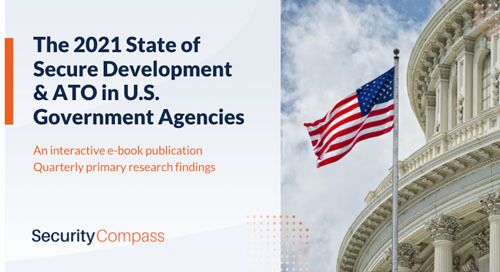Static Version
Introduction
The US President issued a US Cyber Executive Order in May of 2021 that established new rules for government suppliers to enhance cybersecurity. Recognizing cybersecurity as a “core national security challenge”, it came shortly on the heels of a software-firm hack that involved data compromises across 9 federal agencies and 18K companies. The acceleration of cyber attacks in 2021, against a broader set of industries including governments and public utilities, has led to a need for increased complexity of defense.
The dilemma being confronted by U.S. government agencies is that while they are increasingly under attack, they are also under mounting pressure to modernize their IT systems and consistently deliver better services at lower costs. Government agencies must comply with increasingly stringent cybersecurity requirements to obtain Authority to Operate (ATO). Rapidly developing and deploying secure software in a way that meets ATO requirements, especially within environments where software project volume, complexity, and delivery pace is high and security expertise is in short supply makes attaining ATO or maintaining continuous ATO (cATO) extremely difficult.
This report provides an overview of key findings on a comprehensive study of the topic commissioned by Security Compass. The report quantifies the challenges and opportunities being confronted by US government agencies at the federal, state and local levels. Software development methods, security expertise, developer controls and mitigations, communication approaches, and current approaches to ATO compliant software development are explored.
Shifting Security Left
Overall, over half of respondents (55%) indicate that “shifting left” is either a top priority or one of the top three priorities in the software development process within their organization. This result is even more pronounced among agencies developing their own software, particularly among Federal Agencies.
Improving Software Time to Market
Improving software time to market is a priority for over half of US government agencies.
This finding is particularly true for Agencies developing their own software applications.
While a quarter of all Agencies do not measure speed to market, those developing custom software are more likely to and further, Agencies who view speed as their Top Priority certainly do so.
Ensuring Secure Coding Best Practices
Training and automated security testing are the two most common means to ensure secure coding best practices. Many still hold to manual security testing as well. The delivery of securing coding requirements remain primarily an even mix of spreadsheets and emails.
Keeping Up With Security Standards
Almost 9 out of 10 (87%) of respondents agree or strongly agree that their teams are doing a good job keeping up with compliance standards. The challenge is the length of time it takes individuals to stay on top of changing compliance requirements. This lengthy time further translates into lengthy processes defining security for both new and existing projects.
Implemented Controls
Worryingly, once controls have been implemented, almost a third (30%) do not know how implementation of these controls are tracked. Most use excel for tracking inherited security. Not surprisingly then, the majority believe that tracking inherited security compliance from vendor/infrastructure solutions would help increase the speed of their software development lifecycle.
Authority to Operate (ATO)
Overall, only a third of Federal Agencies are using Continuous Authority to Operate (ATO). A major challenge many US government agencies face is the time to achieve ATO, with over a quarter of respondents indicating that it takes them four months or more to do this, a figure even higher within Federal agencies. A quarter of respondents are dissatisfied or only partially satisfied with their ATO process.
Challenges and Developments
Budget constraints are the most frequently cited impediment Agencies at all levels of government are facing in implementing DevSecOps. Advancements in cloud technology are having a major impact on DevSecOps, although at the Federal level, Secure Software Supply Chain and SBOM are ranked even higher.
Conclusion
Despite the need to modernize IT systems — to produce and deploy higher quality, lower cost, cyber-secure software — many US government agencies at all levels are struggling. Manual processes supported by spreadsheets and document management systems still prevail in maintaining cybersecure systems. Not only does this result in slow software deployment cycles, but it also too often misses the details that DevOps teams require to understand, implement, and validate that their software meets US Federal cybersecurity standards.
Our research suggests that most are doing as good a job keeping up with compliance standards as could be expected under these circumstances. The challenge is the length of time it takes individuals to stay on top of changing compliance requirements — in particular for new software projects — and as follows, the time to achieve ATO.
US government agency software development teams need help. They need help enabling rapid or continuous ATO attainment at scale that translates complex U.S. federal government regulatory standards and frameworks into actionable tasks. They need to implement at greater scale and track in near real time, and to do so despite the budget challenges they face. To reduce the time required to obtain ATO requires automated approaches, both in requirements generation and with continuous assessment of security and risk controls.
